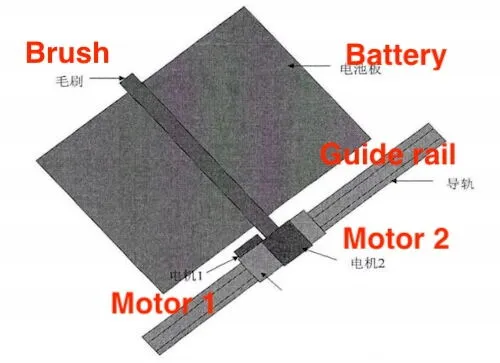Overall Design of Automatic Solar Panel Cleaning Systems
On this page
1. Intelligent Sensing Module of the System
The intelligent sensing module consists of three sensors: light intensity, external temperature, and pressure. When the automatic solar panel cleaning system is in operation, external environmental factors must be accurately analyzed to determine when to start and stop the system. The intelligent sensing module is divided into two units: a photovoltaic panel surface pollutant measurement unit and a temperature measurement unit. The detection unit of this system consists of three sensors: temperature, light intensity, and pressure. The sensor used in the turbidity detection unit of this system is a silicon photocell. In addition, an atmospheric temperature sensor is selected to measure the external temperature, effectively monitoring the ambient temperature of the photovoltaic panel. A pressure sensor is required in the spray control system to detect pressure and regulate the amount of water sprayed.
2. Control system
As a key component of the outdoor photovoltaic panel automatic cleaning system, the performance of the control system significantly impacts the system's ease of use and cleaning efficiency. The control unit is categorized by performance and generally consists of a main control unit, an execution motor, sensor detection, heating control, spray control, and a power supply. The main control unit in this project uses the TMS320F2812 as the central processor. The execution motor is a DC servo motor that can adjust speed and maintain high positional accuracy. The sensor employs a silicon photocell as a light intensity detection device to control the automatic start and stop of the system, while an atmospheric temperature sensor detects external ambient temperature to regulate the system's heating function. A pressure sensor controls the amount of water sprayed during the process.
3. Cleaning module
The function of the cleaning module is to move the cleaning roller brush back and forth across the photovoltaic panel once the cleaning operation begins, effectively completing the cleaning process.
3.3.1 Functional Design of the Cleaning System
The design of this project directly obtains the working voltage from the photovoltaic panel, detects and analyzes the surface coverage of the panel using a photoelectric sensor to control the automatic start and stop of the system, realizes automatic heating through the temperature sensor when the external ambient temperature is too low, and controls the water spraying amount using a pressure sensor to monitor the nozzle pressure during the cleaning process.
The detailed functions are as follows:
The detailed functions are as follows:
(1) Automatic start and stop
The photovoltaic panel automatic cleaning device designed for this project is primarily used to remove pollutants from its surface. After studying and analyzing previous cleaning methods for photovoltaic panels, this project aims to develop a new, environmentally friendly, intelligent cleaning control system. The microcontroller receives data on external climate conditions and the surface state of the solar panel from the sensing unit to determine when to start the cleaning system, eliminating the need for a manual switch. The system will then automatically turn off after cleaning is completed.
(2) Automatic cleaning
The automatic cleaning device measures the external environment and sunlight intensity in real time to determine when cleaning should start. When these factors meet the specified criteria, the system indicates that cleaning is complete.
(3) Self-heating
Since the cleaning agent used in this design is water, it may solidify when the outdoor temperature drops too low in winter, which is detrimental to the photovoltaic panel. Therefore, when the temperature sensor detects that the external temperature is below 1°C, the control system automatically activates the heating element to prevent ice and snow from covering the surface of the solar panel, thus ensuring effective cleaning. This design employs a special conductive silver paste applied through screen printing to create a heating element between the tempered glass layers of the solar panel. Once power is applied, the heating function is activated.
(4) Self-powered
This system is powered by the photovoltaic panel’s storage battery, so no external power supply is required. The panel itself converts the power needed for the cleaning system. This project uses an LM2596 switching voltage regulator to convert +12V to +5V and an AMS1117-3.3 voltage conversion chip to further convert +5V to +3.3V.
3.3.2 Mechanical Structure of the Cleaning System
The main components of the automatic cleaning system designed in this paper include the mechanical frame for holding the photovoltaic panel and the roller brush mounted on the sliding rod.

Figure 2-3 The mechanical structure of the roller brush system

Figure 2-3 The mechanical structure of the roller brush system
(1) External Mechanical Frame
This part of the frame mechanism mainly consists of a guide rail and a sliding rod that are connected to each other. A slider, which drives the roller brush, is mounted on the guide rail. One end of the sliding rod is connected to the drive motor, while the other end is attached to the slider. The cleaning roller brush is mounted on the part of the sliding rod nearest to the photovoltaic panel. Its length matches the width of the photovoltaic panel, with the bristles positioned close to the panel’s surface, ensuring smooth contact.
(2) Cleaning Brush Holder
When the drive motor operates, the slider moves along a predetermined path, driving the sliding rod. The reciprocating motion of the sliding rod propels the cleaning roller brush across the photovoltaic panel’s surface. This action removes dust and other pollutants, achieving automatic cleaning."